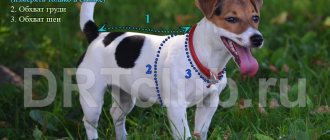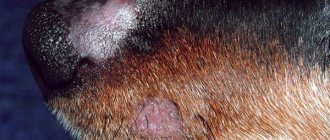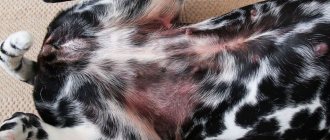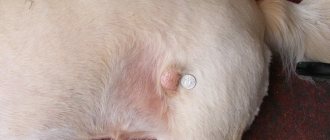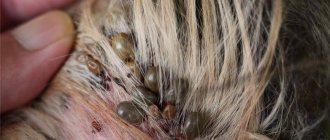Some owners resort to treating eczema in dogs at home, not realizing the possible risks for themselves and their pet. This dermatological disease is often accompanied by complications, so any mistake can result in serious consequences. Instead of self-medication, veterinarians recommend seeking help immediately after the first alarming symptoms appear.
What is eczema in dogs: explanations and photos
Eczema is a type of inflammation that occurs on the epidermis (outer layer of skin) and gradually spreads to deeper layers. Dog hair masks the lesion for a long time, preventing its detection at the initial stage. Despite this, inflammation always occurs due to internal and external irritants, which means it can be prevented.
The inflammatory process is accompanied by the appearance of ulcers, roseola (rash), papules or vesicles (bubbles with liquid). Depending on the number of rashes, eczema can be monomorphic (only one type) and polymorphic (several types at the same time).
Symptoms
At the initial stage, the pathological process occurs unnoticed by humans, especially if the dog has thick or long hair. You can suspect the presence of wet eczema in your pet based on the following signs:
- The dog regularly scratches the same place, whining in pain;
- In this area, the hair falls out a lot and does not fit tightly to the body;
- At the site of baldness, areas of redness form, a rash develops, and the skin temperature rises;
- Because of the pain, the dog does not allow the person to examine the lesions, runs away and hides;
- Sweat glands in dogs are located primarily on the paw pads and nose, but not throughout the body, so if there is moisture under the fur, you should take the animal to the veterinarian;
- With a long course of the disease, the general condition of the pet worsens, signs of intoxication appear: dehydration, dyspeptic disorders, apathy;
- The dog refuses food, his body temperature rises, and physical activity decreases.
Forms of the disease
In addition to the number of rashes, several other factors are taken into account when classifying the disease. These include the nature and duration of the course, as well as the cause of its occurrence.
Dry and weeping
According to the nature of the course, eczema in dogs can be dry and wet (weeping). In the first case, the skin at the site of the lesion becomes dry and flaky, and dandruff appears. In the second case, the inflamed surface becomes moist and shiny, and purulent crusts form along the edges of the wound.
Acute or chronic
Depending on the duration of the disease, it can be acute or chronic. In the first case, clear clinical signs are observed that worsen the animal’s quality of life, and in the second case, alternating remissions and relapses are observed. The chronic type is difficult to treat, so inflammation remains on the body from several years until the end of life.
Classification by origin
Depending on the origin, there are 3 forms of the disease. These include:
- Reflex
. Develops due to external and internal influences. The former include ectoparasites, toxic substances and dirt, the latter – diseases of internal organs, helminthiases and allergies. Allergic eczema in dogs provokes the development of a dry form, but when bacteria penetrate the affected area, it can develop into a wet form.
- Traumatic
. It occurs as a reaction to any type of injury (bites, abrasions, burns, blows) left without timely treatment. Provokes the development of a weeping form.
- Neuropathic
. The rarest form, resulting from a vegetative disorder. Lesions are symmetrical and can combine dry and wet forms.
In addition to the main reasons listed in the classification, there are a number of factors that provoke the appearance of skin rashes. Most often, older dogs with low immunity and breeds with folded skin suffer from the disease.
Wound treatment technique
How to treat a weeping wound on a dog? The hair around the lesion is carefully cut off and the wound is washed using antiseptic and bactericidal preparations. In addition, the edges are washed with warm soapy water to remove crusts of dried exudate and dirt. It is highly recommended to cover the affected surface with surgical gel or at least a cotton-gauze bandage during treatment. This is done to additionally protect the wound channel from contaminated water, hair, and other debris.
Causes of eczema in dogs
Sometimes completely harmless factors can act as provocateurs. A skin reaction may occur to new food, incorrectly selected shampoo, dust or a dirty bed. The most common causes of skin inflammation include:
- low-quality and allergenic products;
- weak immune system and increased susceptibility to allergic reactions;
- prolonged accumulation of moisture in skin folds;
- exposure to alkalis and acids;
- hormonal disorders and the presence of chronic diseases;
- poor hygiene and insufficient animal care;
- excessive or insufficient production of fatty secretions;
- prolonged stress;
- swimming in polluted waters;
- overheating and hypothermia.
In pets with shaggy and thick hair that fits tightly to the body, it is almost impossible to determine the disease at the initial stage. For this reason, veterinarians recommend regularly inspecting your pet's skin for lesions after every walk.
Particular attention should be paid to at-risk breeds: Shar Peis, Pugs, Bloodhounds, Mastiffs, English Bulldogs and Basset Hounds.
Causes
Eczema is an inflammatory process that affects the upper and lower layers of the animal’s skin. Most often, the pathology affects dogs with a thick undercoat, multiple folds on the skin, and elderly pets.
Inflammation occurs in certain areas of the skin, most often the area between the fingers, near the ears, tail, and neck is affected.
- insect bites, parasitic infections;
- intolerance to chemicals contained in detergents;
- overheating – eczema often occurs in pets who like to bask near the fire;
- improper care of your pet – infrequent or excessively frequent hygiene procedures;
- unhealthy diet, vitamin deficiency, obesity;
- weak immunity, tendency to allergic reactions;
- hormonal imbalance, disruption of metabolic processes;
- fungal infections;
- frequent stress, nervous shock;
- dry, sensitive skin;
- ordinary and sunburns;
- pathologies of the liver, kidneys, digestive tract;
- violation of the integrity of the skin.
In dogs with long hair, it is difficult to detect eczema at the initial stage of development of the disease, which can cause severe complications. Only regular examination of the animal and contacting a doctor if changes in the skin appear will help save your pet from an unpleasant disease.
Course and development of pathology
The beginning of the development of pathology is erythema - swollen redness of the surface layer of the skin. It occurs due to scratching caused by severe itching. Over time, papules appear on its surface - small tubercles that are gradually filled with liquid contents. After filling the voids and increasing in size, the resulting papules transform into vesicles. At this stage, the disease occurs in 2 scenarios:
- Dry form
. The liquid in the bubbles gradually dissolves, so the surface remains dry. Dried papules become crusty and peel off. For this reason, dandruff and flaking occur at the affected area.
- Wetting form
. The contents of the vesicles darken. Bursting blisters spread pus over the surface, inflaming neighboring areas and provoking the development of extensive weeping ulcers.
The rate of development of the disease is individual for each animal. Some stages occur so quickly that they cannot be detected without the help of laboratory diagnostics.
Symptoms in different forms
The first symptom of the disease is restless behavior caused by severe itching. The animal constantly itches, gnawing into the affected area with its teeth. At this stage, the owner may notice erythema.
Symptoms and treatment for weeping and dry eczema in dogs are different. In the first case, symptoms are accompanied by:
- pain (the pet does not allow you to touch the affected areas and whines while scratching);
- moisturizing the skin surface;
- chills and fever;
- loss of appetite and severe weight loss;
- apathy, nervousness and sleep disturbances;
- bowel disorder.
At the site of wet ulcers, focal alopecia is noted. Wounds appear with ichor flowing out, which sticks the fur together. Foci of inflammation gradually merge, increasing the affected area.
The dry type of pathology is accompanied by more severe itching in the absence of pain. In areas of peeling, the hair stands on end and thins out a little, and then begins to fall out in clumps. Dandruff and seborrheic plaques form on the problem area. Most often the sternum, back and withers are affected.
Treatment with folk remedies at home
Eczema in dogs can be treated with folk remedies. There are several effective recipes:
- Mix equal amounts of glycerin and chopped fresh burdock leaves. Apply the paste to the affected skin 2 times a day;
- rub viburnum or strawberries through a sieve. You can connect them. Apply the resulting mass in an even layer to the affected areas. This will quickly relieve itching and reduce inflammation;
- take a fresh cabbage leaf, mash it a little with a fork, add an even layer of birch tar. Attach to the wound, secure with a bandage;
- To wash wounds, prepare a decoction of elecampane. Pour 2 tbsp. l. dry raw materials 0.5 liters of boiling water. Boil for 3-5 minutes over low heat. Remove, strain, and after cooling, wash the wounds with the decoction several times a day;
- To sprinkle on weeping eczema, mix starch and a couple of drops of iodine. Sprinkle on the skin to dry the wounds.
Eczema causes a lot of discomfort and pain for dogs. Many factors can trigger the disease. The owner must closely monitor the pet’s condition and fill the diet with healthy foods. In the treatment of eczema, an integrated approach and timely consultation with a doctor are important.
Is canine eczema contagious?
The disease is not contagious to humans or other domestic animals. Despite this, it is recommended to follow basic precautions when treating wounds: wash your hands and wear protective gloves. Otherwise, pus containing bacteria or fungi can get onto the damaged surface of human skin and cause an inflammatory process in the owner. This situation is unlikely, but quite possible.
How to diagnose
To fix the problem, you need to find out its exact cause. For this purpose, during the examination, the veterinarian must take a blood test, skin scraping and ultrasound of the internal organs from the four-legged patient. If parasites are suspected, stool and urine tests may be required.
How and with what to treat eczema in a dog
Complex treatment involves combining external treatment of wounds and ulcers with internal medication. It is selected individually, taking into account the age of the animal, the type and cause of the pathology.
Medicines, ointments and sprays
If there is copious discharge of serous or purulent fluid, infusion therapy (droppers) with sodium bromide, calcium chloride or sodium hyposulfite is carried out. If abnormalities in the liver are detected, hepatoprotectors are prescribed without fail. Severe anemia is eliminated with blood transfusions and immunomodulators.
The choice of medications depends on the form of pathology:
- Dry
. Treat with glucocorticosteroids (Dermozolon, Fluorocort, Cortomycetin) and antihistamines (Suprastin, Diphenhydramine). The skin is moisturized with special shampoos, gels, ointments and sprays. When choosing a product, it is important to combine an anti-inflammatory and antibacterial effect to avoid secondary infection.
- getting wet
. Eliminate with antibiotics (Sinulox, Erythromycin), which are used in combination with sorbents. To treat wounds, tar soap, Lassar paste, Salicylic acid and Terramycin spray are used, which help restore the skin and protect against re-infection.
Pain is relieved with painkillers and novocaine blockade. To relieve stress, sedatives with a calming effect are prescribed. For the entire duration of treatment, the pet must wear a protective collar to prevent licking of ointments and scratching of wounds.
Eliminate the root cause
After identifying the cause of the disease, it is necessary to eliminate it. To do this you will have to:
- treat the animal for external or internal parasites;
- regularly carry out not only dry, but also wet cleaning, paying special attention to the sleeping area and feeding troughs;
- take care to create a comfortable environment in the house, eliminating dampness, cold and too high temperatures;
- protect your pet from exposure to ultraviolet radiation and direct sunlight;
- change care products by choosing veterinary hypoallergenic products;
- refuse aggressive household chemicals;
- Change a collar or harness that causes contact damage.
Additionally, the dog is prescribed therapeutic diets and special procedures. It is necessary to care for the affected skin on the paws, abdomen, ears and other affected areas until the skin is completely restored.
Diet and care
To regenerate the skin, foods containing large amounts of sulfur, cobalt and zinc are introduced into the diet. Amino acids include methionine and cysteine. Meat and offal are temporarily limited, with an emphasis on dairy and plant foods.
After carefully cutting off the fur, the areas of inflammation are treated with special sterile wipes, and the dried crusts are soaked with chlorhexidine. Additionally, the surface is treated with ichthyol, zinc or xeromorphic ointments that absorb seals. Among folk remedies, it is permissible to use freshly squeezed plantain juice, honey, decoctions of celandine, nettle, burdock and string. All medications are prescribed by a veterinarian.
Duration of treatment
The treatment period takes from 2 weeks to several months. The duration depends on the severity of the pathology and compliance with medical recommendations. If the owner stops care immediately after the first improvements, then in the future the disease may worsen and become chronic.
Treatment of weeping eczema at the veterinarian
After bringing in an animal with suspected skin disease, the veterinarian conducts an external examination. The specialist interviews the dog owner, collecting anamnesis, and identifies characteristic symptoms of the pathology. After confirming the diagnosis, he determines the further treatment regimen:
- Conducts unscheduled flea and tick treatment;
- Collects feces, blood and urine for analysis to exclude parasitic infestation;
- The places where the animal's body comes into contact with collars, harnesses and bandages are checked to detect hidden wounds;
- If the cause of the disease is diseases of the internal organs, a course of appropriate medications is prescribed.
The owner must clear the apartment of potential allergens to reduce the risk of re-development of the disease.
In the chronic form of the pathology, infusion therapy is prescribed. Droppers allow you to drive the drug through the blood in a few minutes, which will affect all parts of the body. This is necessary because prolonged wet eczema quickly spreads over the entire surface of the skin and begins to poison the body. The IV solution consists of saline solution, 5% glucose solution and Ringer's solution.
Liver protection
If the development of a skin disease provokes liver damage, the dog is prescribed hepatoprotectors:
- Legaphyton. The drug is prescribed at the rate of 1 tablet per 10 kg of body weight, containing 200 mg of the active substance. If the oral agent contains 50 mg of the active compound, then the dosage increases to 1 tablet per 2.5 kg of dog weight.
- Hepatovet. A single dosage is 1 ml of solution per 10 kg of dog weight. The daily dose of the drug reaches 2-3 ml. The product is poured into the pet's mouth.
- Covertal. The maximum daily dosage should not exceed 4 ml. The solution is administered intramuscularly or subcutaneously at the rate of 0.1 ml per 1 kg of weight.
- Hepatoject. The solution is administered subcutaneously, intravenously or intramuscularly in a dosage of 2 to 5 ml.
Hepatoprotectors are prescribed for complex treatment to protect the liver from the negative effects of antibiotics. Treatment of wet eczema may require long-term use of many tablets and the administration of large amounts of solutions, due to the toxicity of which liver cells begin to break down over time.
Disinfection of wounds
In the affected area, it is necessary to completely cut off the hair for medicinal treatment. If the surface of the skin is dirty, it must be washed with the following products:
- A decoction of chamomile, oak bark, burdock leaves;
- Pale pink solution of potassium permanganate;
- Aqueous solution of Chlorhexidine with a concentration of 0.05%;
- 3% hydrogen peroxide solution.
Creams and ointments
The affected area is treated with special creams and gels for topical use. Bathing the dog should be done with shampoos.
The following types of remedies are often prescribed:
- Zoomikol;
- Chemi spray;
- Antibacterial shampoos with Chlorhexidine;
- Triderm;
- Sulfur-tar ointment;
- Ranosan;
- Aluminumspray;
- Kubatol;
- Sea buckthorn oil;
- Gel Saphroderm;
- Vedinol.
Preparations that are applied to the skin have anti-inflammatory and antibacterial effects. Pet washing products accelerate skin regeneration and cellular renewal and dry out wet eczema.
Antimicrobials
To eliminate skin infections, antibiotics are prescribed for oral and intramuscular administration:
- Ciprofloxacin. Each unit of the drug contains 500 mg of active substance. The dog is given 0.5-2 tablets every day. The duration of therapy is 2 weeks. The daily dosage varies depending on the weight of the pet and the severity of the pathology.
- Erythromycin. Given once a day. The duration of treatment is 2 weeks. The daily dosage is determined at the rate of 15-20 mg per 1 kg of weight.
- Sinulox. The pet is given the drug 12.5 mg of active substance per 1 kg of weight for 14 days in the mornings and evenings. There should be at least 12 hours between doses.
- Amoxicillin. A 15% solution is administered intramuscularly at 1 ml per 1 kg of dog weight. The duration of therapy is 7 days.
Vitamins
To speed up cellular renewal of the skin, the veterinarian prescribes metabolic drugs and multivitamin complexes:
- Complex therapy: Retinol, 5% Tocopherol solution and Ascorbic acid. Vitamins A, E and C are administered to the dog one by one in a daily dosage of 1 ml. You can replace the solutions with the oral drug Trivitamin. It comes in drops. The pet is given 2-4 drops with food or water.
- Katozal. The solution is administered in a dosage of 2.5-5 ml intramuscularly.
- Gamavit. The drug is administered inside a vein or muscle at the rate of 0.5 ml per 1 kg of weight. Injections are given 2-3 times a week. The duration of therapy is 1 month.
- Vitam. Prescribed at the rate of 3-5 ml per 10 kg of dog weight. It is administered 2-3 times a week for 4 weeks.
Treatment of neuropathic eczema
If the cause of the disease is stress or emotional shock, the dog is prescribed sedatives:
- Vetspokoin. Give 1 tablet for every 10 kg of weight 1 time per day for 14 days.
- Cat Baiyun. 1-3 tsp. From 2 to 4 times a day during the entire treatment period.
- Stop stress. The daily dosage is set at the rate of 0.5 tablets per 10 kg of weight.
The drugs have a calming effect on the body. The daily dose of the drug should not be exceeded - the drugs can harm the dog’s nervous system.
Therapy with folk remedies
Alternative medicine methods can only be used with the permission of a veterinarian as additional therapy. At the same time, it is prohibited to stop taking medications. For wet eczema use:
- Applications made from cabbage leaves and birch tar. A layer of tar is applied over the eczema, which is covered with a leaf of white cabbage. The compress can be secured with a bandage and changed once a day.
- Celandine cream. Celandine must be ground to a paste and mixed with petroleum jelly in a ratio of 1:4. The resulting mixture is applied to a bandage and pressed onto the lesions. The dressings are changed 2-3 times a day until the wounds are completely healed.
- Infusion of currant leaves. The green part of the plant is poured with 0.5 liters of boiling water and left under a closed lid for an hour. After cooling, wash the affected area with the infusion.
- A decoction of elecampane. 2 tbsp. l. The dry collection is poured with 500 ml of boiling water and put on fire, boiled for 5 minutes. After this time, cool and filter the mixture. Wounds are washed with the resulting decoction.


